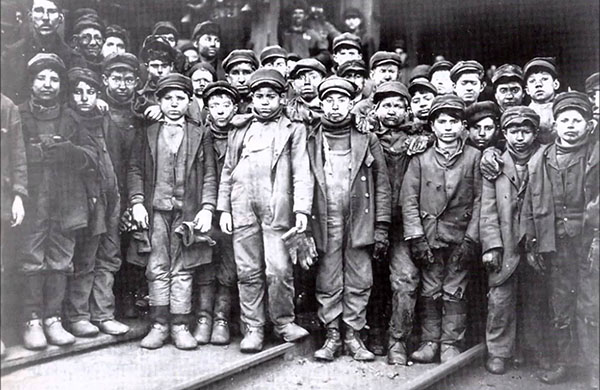For many years, child labor was seen as necessary and helpful not only to businesses but also to families who desperately needed the additional income.
Since Colonial times, children in the United States had no protection against harsh working conditions and pitiful compensation. Children were sent from impoverished families in Europe to the New World as indentured servants. Under contract, they were required to serve their hired master for a designated number of years to pay for passage, room and board. Even those who came without such obligations had to work in factories, mines, mills and other harsh environments to earn their keep or help support their families. Until as late as 1900, one in six children from ages 10 to 15 worked outside the home.
Massachusetts First to Pass Child Labor Law
From the earliest days of the United States, efforts were made to curtail child labor. In 1836, Massachusetts became the first to pass an actual law prohibiting children under fifteen years of age from working in factories. That law also required children to attend school for at least three hours per day. Six years later, again Massachusetts led the way by limiting working hours for children to ten hours per day. A few other states followed, but these laws were seldom enforced.
Several political and labor groups made noise for the next several years objecting to various working conditions for children, but little change was made. In 1916, an attempt to stop interstate and international commerce that involved child labor (although only within the 30 days immediately preceding shipment of such goods) was passed, then declared unconstitutional, then passed again in 1918 and again found unconstitutional. It seemed there was little heart for interfering in profitable business.
Congress attempted in 1924 to give the federal government power to regulate child labor rather than have it under the jurisdiction of each state. There were too few states supporting such an idea and it never passed.
Great Depression Increased Use of Child Labor
The onset of the Great Depression only made those conditions worse. Children were seen as cheap, exploitable labor with little regulation. Companies fought for their right, calling it “a child’s right to work” rather than pay an adult two or three times as much for the same job.
According to an article in Survey Graphic magazine, published in 1937, 10 to 14 year old boys (and a few girls) in southern states worked as “chippers” – those who scarred trees and set pans to catch the gum for turpentine – and “dippers” – those who collected the gum – for little more the eight cents per hour. Children of the same ages often worked in factories as machine helpers or operators for less than 75 cents per day.
“Breaker Boys” worked in coal mines, pulling rocks out of processed coal, then sorting chunks of coal into sizes for commercial sale. From early morning until after dark, these children worked in tunnels, breathed clouds of coal dust and saw little daylight. Those who didn’t die of black lung or lung cancer faced a life time of chronic respiratory and other disease, as well as a generally shorter life expectancy.
National Industrial Recovery Act of 1933
In 1933, Congress passed the National Industrial Recovery Act as part of President Franklin Roosevelt’s New Deal. For the time it stood, three important changes were made that improved conditions for children and eased the terrible burden borne by adults caught in the Great Depression. First, child labor was outlawed in most industries besides agriculture and domestic work. Thousands of positions that had been filled by children were now open to unemployed adults. Second, a maximum number of hours were set for a standard work week. Employers who had been able to use a single worker for 60 to 80 hours a week would now have to hire two instead. And to help those workers with few hours than before, a minimum wage was established.
According to Beulah Amidon, a writer for Survey Graphic magazine in 1937, “the NRA code period was the first time in this country that child labor figures went down while employment figures rose.” This was clear evidence that the removal of children from the work force also greatly benefited unemployed adults in the U.S.
Although the NRA was declared unconstitutional in 1935, Roosevelt came back with the Fair Labor Standards Act in 1938 which made the minimum wage, maximum hours and anti-child labor provisions set out in NRA permanent.
References:
- Amidon, Beulah. “Children Wanted”. Survey Graphic. 1937
- Henretta, James, et al. America’s History. Bedford/St. Martin’s. 2008
- Keating-Owen Child Labor Act of 1916
- National Industrial Recovery Act of 1933
- University of Iowa. “Child Labor Public Education Project”. Online. 2010








